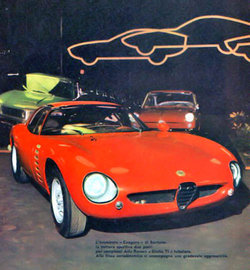Difference between revisions of "Alfa Romeo Canguro"
m |
m |
||
| Line 92: | Line 92: | ||
In order to facilitate entry and exit from the [[interior]], the doors curved through into the roof and were hinged far in front of the [[cockpit]] area. [http://www.italiaspeed.com <small>ItaliaSpeed.com</small>] | In order to facilitate entry and exit from the [[interior]], the doors curved through into the roof and were hinged far in front of the [[cockpit]] area. [http://www.italiaspeed.com <small>ItaliaSpeed.com</small>] | ||
| − | [[Image:cangurobrocure.jpg|thumb| | + | [[Image:cangurobrocure.jpg|thumb|right|250px|'''Canguro Sales Brocure''']] |
| − | + | [[Image:2729061518_1611d17e47_o.jpg|thumb|left|300px|'''Alfa Romeo Canguro X-ray by Makoto Ouchi''' <small>Archivio Perini © - CarDesignTo@Gmail.com</small>] | |
{{Bertone}} | {{Bertone}} | ||
Revision as of 19:07, 3 February 2009
| [[Image:conguro.jpg | 250px]] | |
| Alfa Romeo Canguro | ||
|---|---|---|
| Production Year | 1964 | |
| Country | ||
| Designer | Bertone | |
| Chassis Type | 2S FHC | |
| Number of Doors | 2 | |
| Wheelbase | 2200 mm (86.6 in) | |
| Front Track | 1300 mm (51.2 in) | |
| Rear Track | 1300 mm (51.2 in) | |
| Length | 3900 mm (153.5 in) | |
| Width | 1600 mm (63 in) | |
| Height | 1060 mm (41.7 in) | |
| Ground Clearance | ||
| Length / Wheelbase Ratio | 1.77 | |
| Engine Manufacturer | Alfa Romeo | |
| Engine Location | Front | |
| Engine Alignment | Longitudinal | |
| Coolant Type | Water | |
| Engine Type | DOHC | |
| Number of Cylinders and Placement | S-4 | |
| Valves per Cylinder | 2 (toplam 8 adet) | |
| Engine Displacement | 1570 cc (95.81 cu in) | |
| Bore | 78 mm (3.07 in) | |
| Stroke | 82 mm (3.23 in) | |
| Bore / Stroke Ratio | 0.95 | |
| Unitary Capacity | 392.5 cc/cylinder (23.95 cu in/cylinder) | |
| Number of Main Bearings | 5 | |
| Fuel System Type | ||
| Aspiration Type | Normal | |
| Compressor Type | - | |
| Intercooler Type | None | |
| Catalytic Converter | No | |
| Top Speed | ||
| Transmission Type | 5M | |
| Drive Wheels | RWD | |
In the mid-sixties Bertone designed a new swooping body on an Alfa TZ2 chassis, called the Canguro. Autodelta was never able to put into production and the project was cancelled after just one car had been built. The one-off Canguro was wrecked at Monza by a journalist and it is said to have been rebuilt about a year ago.
The spaceframe of the TZ1 was built at Alfa Romeo’s Ambrosini factory, with the bodywork mainly being created at Zagato in Milan (there were also three glass fibre versions built by Balzaretti Modigliani of Milan), before final fettling and mechanical work was undertaken at Alfa Romeo’s Auto-Delta racing department. The 1.570 cc twin cam engines were also later developed by Conrero to pump out 160 bhp over the original 112.
Bertone was supplied with a new TZ2 chassis (chassis number 101) for construction work to be held over the Autumn of 1964.
In an attempt to make the Canguro design more suitable for any form of production, and also presumably because of the limited time span before the Paris Salon, 90% of the Canguro was made from Giulia TI components. Bertone continued the tubular framework construction for the aluminium bodywork. This firstly reduced the car’s weight tremendously, and suited a low profile shape for improved aerodynamics. Secondly the Gran Turismo character remained therefore intact.
Whether the car was fitted with what would have been an experimental 170 bhp, twin sparkplug per cylinder TZ2 engine is currently unknown. However the Canguro’s sleek shape and lack of a bonnet bulge could indicate that the smaller dry sump TZ2 engine was used.
Photos of the Canguro are misleading, as the actual car appears much lower than images suggest. Its length of 3.900mm was conventional, as was the width of 1.600mm. However, the Canguro was only 1.060mm high, a dramatic 140 mm lower than the original TZ. It was therefore impressive that Bertone had managed to create a generally roomy two-seat interior inside such a low-down volume.
In order to facilitate entry and exit from the interior, the doors curved through into the roof and were hinged far in front of the cockpit area. ItaliaSpeed.com
[[Image:2729061518_1611d17e47_o.jpg|thumb|left|300px|Alfa Romeo Canguro X-ray by Makoto Ouchi Archivio Perini © - CarDesignTo@Gmail.com]
